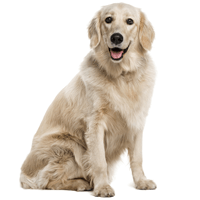
Occasionally seen: Gastric torsion, epilepsy, CPRA, osteosarcoma
Avg Size of Female: Height: 21.5 – 22.5 inches, Weight: 55 – 65 pounds
Avg Size of Male: Height: 23 – 24 inches, Weight: 65 – 75 pounds
Life span: 10 – 13 years
Suggested tests: Hip, elbow, eye, cardiac, blood
Major Concerns:CHD, elbow dysplasia, cataract
Minor concerns: Entropion, distichiasis, trichiasis, cataract, pyotraumatic dermatitis, subvalvular aortic stenosis, OCD, allergies, VWD, cardiomyopathy
Brief History on Golden Retriever Origin
The golden retriever evidently came to America sometime around 1900 by way of Lord Tweedmouth’s sons, transporting them to the family’s farm in Texas. The date that the AKC recognized the breed is a bit unclear, ranging somewhere in time from 1925 to 1932. While this dog was very much appreciated and utilized for its hunting skills and ability, it grew more of a reputation later on as a show dog and as a family companion. The Goldens intelligence and quickness to learn have truly made it a diverse working dog. They are oftentimes used as a guide dog or therapy and service dog for the handicapped. This breed is used in narcotics detection often, thanks to its extraordinary tracking skills and sense of smell. Today, the Golden has kept its spot in the top ten most popular dogs in the U.S.
Golden Retriever Breed Appearance
The Golden is athletic and strong, yet gentle hearted. The front set of legs are straight and substantial, while the hindquarters are broad and feature straight back legs. The medium size feet are round and heavy, with protective pads. The head of this breed has a large skull that features medium-sized eyes that are generally anywhere from light to dark brown in color. The eyes offer an expression of faithfulness and warmth. The ears are triangular in shape, usually folded over and fall close to the cheek. The muzzle blends well with the shape of the skull, and features a well-proportioned nose that is normally brown or black in color. The teeth meet in a scissors bite. The neck of the golden retriever is broad and strong, blending smoothly into the well-balanced body. The gait of this breed is best described as coordinated and graceful. The Golden Retriever is very well protected from weather with a double coat, featuring a water-resistant undercoat. The outer coat can be silky and straight or wavy, and it is very resilient. Heavy feathering of the coat can be found on and around the neck, underneath the tail, and on the back of the thighs. While moderate feathering is found on the underside of the body, and also on the backs of the front legs. The hair that grows on the paws, the front of the legs, and on the head is even and short in length. The color of coat is golden and rather glossy, and comes in a variety of gold shades.
Golden Retriever Breed Temperament
The Golden Retriever is a prime example of the perfect family dog. It is gentle, friendly, happy and playful and is most content when it is spending time with it’s family. It does extremely well with children, though its tendency to overwhelm with affection may be too much for very young children. This breed also does very well with other non-canine pets and dogs. This breed is very easily trained as it loves to learn and receive positive reinforcement. You could say this dog truly enjoys pleasing its owner. At times, this breed may get distracted during training sessions due to its enthusiasm and intrigue for everything around it.. Mental maturity usually takes about three years or more, which means the Golden keeps a very puppy-like nature for quite some time. This dog can be used as a watchdog, as it will bark at people approaching the home. Though it is not ideal to be used as guard dog, it is overall just too friendly for this type of work. The Golden Retriever requires a lot of affection and socialization from humans in order to be happy. It is a very friendly and lovable dog, which can be entertained for hours simply by spending time with it or tossing a stick around the yard. This dog requires much of the owner’s time and attention because it yearns for that love daily. If given substantial amounts of love and affection, the Golden makes a perfect addition to the active family.
Golden Retriever Breed Maintenance
The Golden Retrievers double coat is not known to mat or tangle, but in order to keep it in good shape it is recommended to brush the coat twice a week. Using dry shampoo regularly is recommended, and bathe only when necessary to avoid stripping the skin of natural oils. The Golden is an average shedder. Daily exercise is very important to this particular breed to keep them youthful and healthy. It loves to run and play, and burn energy when it can. This breed is not recommended for apartment dwelling, as it does best in a home with a medium to large yard. The Golden Retriever is somewhat active when indoors as well, unlike some other breeds. Daily walks around the neighborhood or to the park, and the chance to run, retrieve, and play is absolutely essential to the physical and mental health of this dog.
 Toledo, United States.
Toledo, United States.